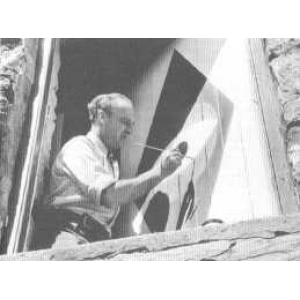 A lesser known figure whose work and knowledge of occult matters was instrumental in the formation and build up of the new and present day Wicca/Witchcraft movement, was the work and dedication of Cecil Hugh Williamson. He was the Founder of the Witchcraft Research Center during the war, and the Museum of Witchcraft in Castletown on the Isle of Man.
A lesser known figure whose work and knowledge of occult matters was instrumental in the formation and build up of the new and present day Wicca/Witchcraft movement, was the work and dedication of Cecil Hugh Williamson. He was the Founder of the Witchcraft Research Center during the war, and the Museum of Witchcraft in Castletown on the Isle of Man.
Williamson was born into a fairly well to do family on the 18th September 1909 in Paignton, South Devon. His father was an influential career officer in the Fleet Air Arm of the Royal Navy. Williamson’s interest in witchcraft and the occult was aroused by an incident that occurred in 1916, which he describes as “a major public act of witchcraft”. In December of that year he witnessed an old woman (reputed to be a witch) being striped of her clothing and beaten. Young as he was (six years old) he ran to her defence and for his efforts was beaten himself. The old woman later befriended young Williamson and taught him all she knew about witches.
Williamson was a prodigious collector of artifacts on witchcraft, and had collected thousands of magical objects and items of occult interest. He decided that best use he could make of them was to create his own business in the form of a “Witchcraft Museum”. But this was not so easy to do, for witchcraft in those times was still viewed with skepticism. In 1947 he set up his first site in Stratford-on-Avon, but was ran out of town due to difficulty with local antagonism. Eventually he had to move out of England and settle in Castletown on the Isle of Man. There his ideas were more favorably accepted, and he opened the Folklore Center of Superstition and Witchcraft in 1949. On the advice of his wife Gwen, the center also included a Witches Kitchen to be used as a restaurant and to boost business.
After the repeal of the old witchcraft laws in 1951, Williamson decided to return to England and try again. In 1952 he sold the buildings of the Castletown museum to Gerald b Gardner and moved his collection of artifacts back to England. He started with a museum in Windsor, near to Windsor Castle. Initially it proved a success and was a splendid tourist attraction, but after the first season ended local residents again grew skeptical and antagonistic, and forced him to move on.
In 1954 he relocated to Bourton-on-the-Water in Gloucestershire. There he was treated to the same kind of harassment he had met in other locations, included: Sigils painted on his doors, dead cats left on his doorstep at night and even had a wing of the museum destroyed by arson. Williamson moved several more times due to this sort of antagonism and in the process started up museums such as: the Museum of Smuggling at Polperro in Cornwall, and the Museum of Shellcraft at Buckfast in Devon. He finally settled in Boscastle, Cornwall and there opened his final Museum of Witchcraft in 1960, the one still running today.
Williamson retired in 1996 and sold the Museum of Witchcraft together with many of its contents to “Graham King” and his partner “Elizabeth Crow”. After his retirement he moved to Witheridge near Tiverton in Devon, taking with him some of the artifacts from the museum he was reluctant to relinquish. He also took with him his extensive collection of occult articles and objects associated with the Witchcraft Research Center.
Following the advice of Aleister Crowley given in the 1940’s, Williamson over the years did not belonged to any particular group or society. He maintained that the services of a witch was a valuable and necessary service to society, especially to the lower classes who cannot afford fancy medical treatments, but he disdained the modern Pagan religion of witches as being "nonproductive of results". According to his own records between the years 1930 – 1997, he took part as a spectator and sometimes as an operative in some 1,120 witchcraft rituals that produced beneficial results. He had known, met with and been taught by some 82 wise women.
Through his knowledge of witchcraft and the occult, and through his network of contacts with those involved, his Museums have done much to provide the means and a central focus point from which the new movement of Wicca and Witchcraft could evolve. Cecil Williamson died on the 09th December 1999. He was 90 years old.
Downloadable books (free):
Yogi Ramacharaka - Science Of BreathJohn Seymour - Irish Witchcraft And Demonology
Charles Webster Leadbeater - The Hidden Life In Freemasonry
Anonymous - The Mysticism Of Masonry








